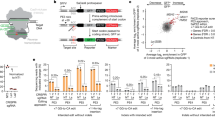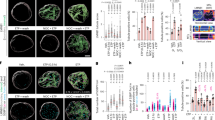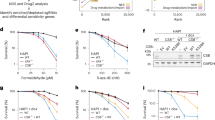Abstract
Understanding the processes of DNA replication, chromatin assembly and maturation, and the replication stress response requires the ability to monitor protein dynamics at active and damaged replication forks. Detecting protein accumulation at replication forks or damaged sites has primarily relied on immunofluorescence imaging, which is limited in resolution and antibody sensitivity. Here we describe a procedure to isolate proteins on nascent DNA (iPOND) that permits a high-resolution spatiotemporal analysis of proteins at replication forks or on chromatin following DNA replication in cultured cells. iPOND relies on labeling of nascent DNA with the nucleoside analog 5-ethynyl-2′-deoxyuridine (EdU). Biotin conjugation to EdU-labeled DNA using click chemistry facilitates a single-step streptavidin purification of proteins bound to the nascent DNA. iPOND permits an interrogation of any cellular process linked to DNA synthesis using a 3- to 4-d protocol.
This is a preview of subscription content, access via your institution
Access options
Subscribe to this journal
Receive 12 print issues and online access
$259.00 per year
only $21.58 per issue
Buy this article
- Purchase on Springer Link
- Instant access to full article PDF
Prices may be subject to local taxes which are calculated during checkout




Similar content being viewed by others
References
Cimprich, K.A. & Cortez, D. ATR: an essential regulator of genome integrity. Nat. Rev. Mol. Cell Biol. 9, 616–627 (2008).
Hoeijmakers, J.H. Genome maintenance mechanisms for preventing cancer. Nature 411, 366–374 (2001).
Berkovich, E., Monnat, R.J. Jr. & Kastan, M.B. Assessment of protein dynamics and DNA repair following generation of DNA double-strand breaks at defined genomic sites. Nat. Protoc. 3, 915–922 (2008).
Bell, S.P. & Dutta, A. DNA replication in eukaryotic cells. Annu. Rev. Biochem. 71, 333–374 (2002).
Sirbu, B.M. et al. Analysis of protein dynamics at active, stalled, and collapsed replication forks. Genes Dev. 25, 1320–1327 (2011).
Salic, A. & Mitchison, T.J. A chemical method for fast and sensitive detection of DNA synthesis in vivo. Proc. Natl. Acad. Sci. USA 105, 2415–2420 (2008).
Moses, J.E. & Moorhouse, A.D. The growing applications of click chemistry. Chem. Soc. Rev. 36, 1249–1262 (2007).
Herrick, J. & Bensimon, A. Global regulation of genome duplication in eukaryotes: an overview from the epifluorescence microscope. Chromosoma 117, 243–260 (2008).
Probst, A.V., Dunleavy, E. & Almouzni, G. Epigenetic inheritance during the cell cycle. Nat. Rev. Mol. Cell Biol. 10, 192–206 (2009).
Kliszczak, A., Rainey, M., Harhen, B., Boisvert, F. & Santaocanale, C. DNA-mediated chromatin pull-down for the study of chromatin replication. Scientific Rep. 1, 1–7 (2011).
Jao, C.Y. & Salic, A. Exploring RNA transcription and turnover in vivo by using click chemistry. Proc. Natl. Acad. Sci. USA 105, 15779–15784 (2008).
Reyes-Lamothe, R., Sherratt, D.J. & Leake, M.C. Stoichiometry and architecture of active DNA replication machinery in Escherichia coli. Science 328, 498–501 (2010).
Aladjem, M.I. Replication in context: dynamic regulation of DNA replication patterns in metazoans. Nat. Rev. Genet. 8, 588–600 (2007).
Raschle, M. et al. Mechanism of replication-coupled DNA interstrand crosslink repair. Cell 134, 969–980 (2008).
Ben-Yehoyada, M. et al. Checkpoint signaling from a single DNA interstrand crosslink. Mol. Cell 35, 704–715 (2009).
Petermann, E., Orta, M.L., Issaeva, N., Schultz, N. & Helleday, T. Hydroxyurea-stalled replication forks become progressively inactivated and require two different RAD51-mediated pathways for restart and repair. Mol. Cell 37, 492–502 (2010).
Szychowski, J. et al. Cleavable biotin probes for labeling of biomolecules via azide-alkyne cycloaddition. J. Am, Chem. Soc. 132, 18351–18360 (2010).
Kim, H.Y., Tallman, K.A., Liebler, D.C. & Porter, N.A. An azido-biotin reagent for use in the isolation of protein adducts of lipid-derived electrophiles by streptavidin catch and photorelease. Mol. Cell Proteomics 8, 2080–2089 (2009).
Capson, T.L., Benkovic, S.J. & Nossal, N.G. Protein-DNA cross-linking demonstrates stepwise ATP-dependent assembly of T4 DNA polymerase and its accessory proteins on the primer-template. Cell 65, 249–258 (1991).
Gallagher, S.R. One-dimensional SDS gel electrophoresis of proteins. Curr. Prot. Mol. Biol. 10.2A.1–10.2A.34 (1999).
Shevchenko, A., Tomas, H., Havlis, J., Olsen, J.V. & Mann, M. In-gel digestion for mass spectrometric characterization of proteins and proteomes. Nat. Protoc. 1, 2856–2860 (2006).
Acknowledgements
This work was supported by the US National Cancer Institute grants R01CA136933 and R01CA102729 to D.C. B.M.S. is supported by a Department of Defense Breast Cancer Research Program predoctoral fellowship (W81XWH-10-1-0226). We thank N. Porter, K. Tallman, D. Liebler and S. Codreanu, who developed the UV-photocleavable biotin azide and optimized methods of photoelution. We also thank L. Marnett, K. Gould, J. McLean and M. Chandrasekharan for helpful advice and discussions.
Author information
Authors and Affiliations
Contributions
B.M.S. developed the protocol and F.B.C. made modifications to omit the formaldehyde cross-linking step. D.C. conceived and supervised the project. B.M.S. and D.C. wrote the manuscript.
Corresponding author
Ethics declarations
Competing interests
The authors declare no competing financial interests.
Rights and permissions
About this article
Cite this article
Sirbu, B., Couch, F. & Cortez, D. Monitoring the spatiotemporal dynamics of proteins at replication forks and in assembled chromatin using isolation of proteins on nascent DNA. Nat Protoc 7, 594–605 (2012). https://doi.org/10.1038/nprot.2012.010
Published:
Issue Date:
DOI: https://doi.org/10.1038/nprot.2012.010
This article is cited by
-
FANCD2 maintains replication fork stability during misincorporation of the DNA demethylation products 5-hydroxymethyl-2’-deoxycytidine and 5-hydroxymethyl-2’-deoxyuridine
Cell Death & Disease (2022)
-
ISG15 conjugation to proteins on nascent DNA mitigates DNA replication stress
Nature Communications (2022)
-
The non-catalytic role of DNA polymerase epsilon in replication initiation in human cells
Nature Communications (2022)
-
MIF is a 3’ flap nuclease that facilitates DNA replication and promotes tumor growth
Nature Communications (2021)
-
Comparative proteomics identifies Schlafen 5 (SLFN5) as a herpes simplex virus restriction factor that suppresses viral transcription
Nature Microbiology (2021)
Comments
By submitting a comment you agree to abide by our Terms and Community Guidelines. If you find something abusive or that does not comply with our terms or guidelines please flag it as inappropriate.



